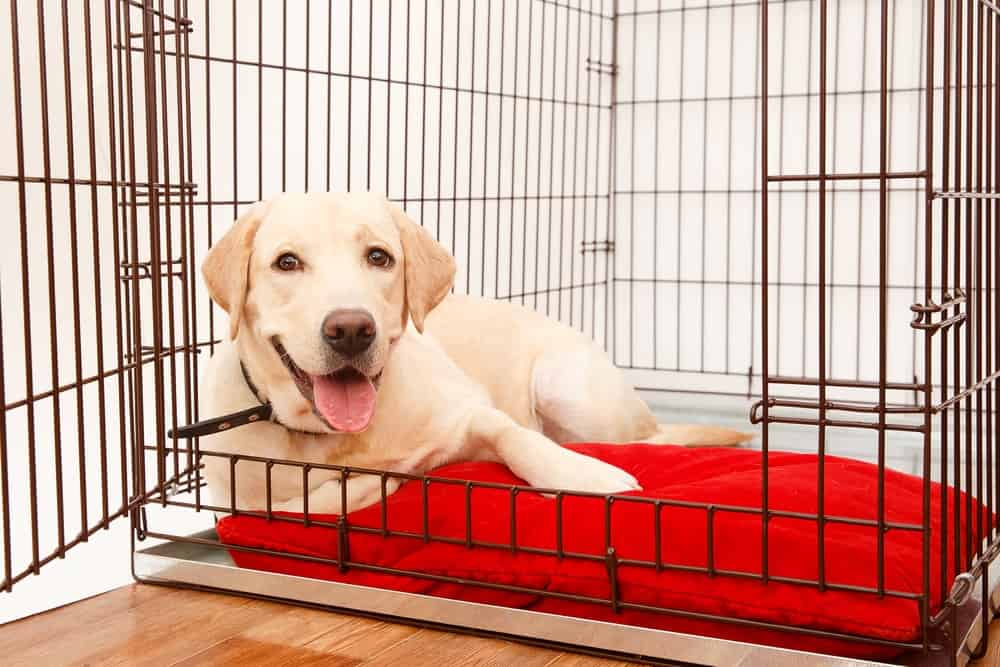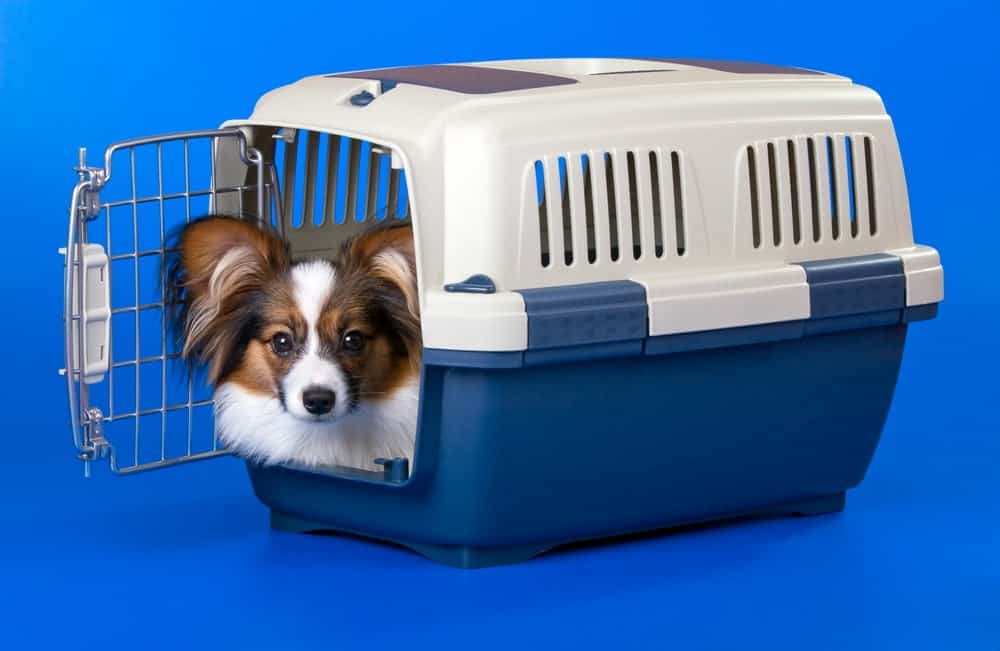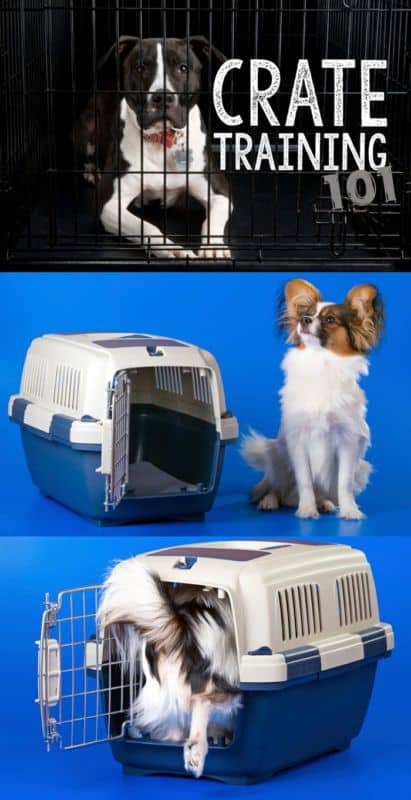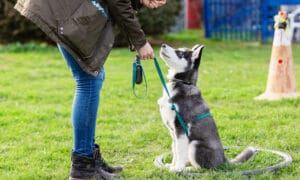“This post contains affiliate links, and I will be compensated if you make a purchase after clicking on my links.”
While a number of pet parents consider crate training to be unnecessary or cruel, that belief couldn’t be farther from the truth!
Properly crate training your dog not only makes certain situations (like travel, boarding, or visits to the veterinarian) easier for you both, it creates a comfortable “den” that your dog will enjoy, assists in potty training, and provides a safe area for your dog to rest and relax during stressful times, like during thunderstorms, when guests are visiting, or when you’re away from home.

Choosing the Right Crate
There are several different types and sizes of dog crates available. You’ll need to consider both your own lifestyle and preferences AND your dog’s needs when choosing which one to use.
Most commonly used is the traditional wire dog crate. Available in any size you could possibly need, these crates are easy to clean, collapsible, and can be upgraded with any number of accessories, like water dishes, mats, or covers that fit perfectly. The downside to these crates is that they’re not portable or safe for use during travel.
The next most popular choice is the travel crate. Also available in a wide range of sizes, these crates are a great choice for frequent travelers, but also work well in a home setting. They are available in both a hard plastic or a soft-sided fabric version.
Or, pet parents can opt for a decorative crate. Made from materials like wood, iron, plastic, or laminate, these crates are designed with style in mind. Often, decorative crates are multi-purpose, doubling as a side-table or planter.
Buy Dog Crates, Pens & Gates Today – Shop over 1,000 Brands at Chewy!

Whichever style crate you choose, the most important decision you’ll make is its size. A dog crate should be large enough for your dog to comfortably stand, lay down, and turn around, but should not be much larger. A crate that is too small could be uncomfortable, dangerous, and lead to serious physical complications and a crate that’s too large won’t serve the purpose of crate training, especially if housebreaking is a main objective.
How to Train Your Dog to Use the Crate
1. Introduce the crate. For the first phase of crate training, you just want to place the crate in a quiet area of your home. The objective is to allow your dog time to become comfortable with the crate in his space, nothing more. Add a few of your dog’s favorite toys, a soft blanket, or a favorite chew toy inside. Do not put your dog inside the crate just yet, but do praise him with lots of treats and petting if he chooses to explore on his own.
2. Encourage your dog to go inside the crate. Once your dog is completely comfortable being near his new crate, encourage him to step inside. Stepping inside a crate for the very first time can be scary for a pup, so don’t force him. Try tossing a few tasty treats or a favorite toy inside and praise like crazy when he goes in. Begin using a cue, like “go to your crate” each time he begins to step inside. Do not close the door at this stage of training, but instead, allow your dog to come and go as he’s comfortable.
3. Begin serving meals or long-lasting treats inside the crate. Now that your dog is comfortable being in and around the crate, begin serving meals inside (with the door open!). He’ll begin to associate his favorite part of the day with his cozy new retreat. At this phase of training, you’ll begin to notice your dog going to his crate at nap time, too.
4. Close the crate door. Now that your dog is totally comfortable in her crate, it’s time to introduce her to being inside with the door closed. Ask her to step inside the crate using your cue, then, gently close the door. Only close the door for a few seconds, then open it and reward her with loads of treats and praise. Continue this step several times a day, building up from only a few seconds in the beginning, to several minutes, to half an hour at a time, but remain close by. It’s still too early to leave her alone inside the crate at this stage.
5. Leave the room. Now that you can comfortably leave your dog in her crate for up to 30 minutes or so (without her freaking out) it’s time to leave her alone. Start by asking her to go into her crate (use your cue!), close the door, and, without making a big deal of it, quietly leave the room for a few seconds and return. If your dog whines, barks, or becomes excited when you leave the room, just ignore the behavior and quietly open the door to let her out – but do not give her a reward unless she’s remained calm and quiet the entire time you were out of the room. Practice this step until you are able to leave the room for at least an hour or longer with your dog remaining calm.
6. Leave the house. Repeat the same process as leaving the room, only this time you’ll step outside of the home. Begin with very short intervals of only a few minutes at a time. Eventually build up to getting in your car and pulling out of the driveway (your dog knows when you’re actually gone!), driving around the block, and back in. When you return home, don’t make a big deal out of it, but do open the crate and reward your dog for behaving while you were away. If your dog is too excited, jumping, whining or barking when you return, wait quietly until he has settled down before opening the crate.
Important Things to Remember
Every dog is different. Some dogs will take to the crate quickly and easily, while others will need to be trained slowly, sometimes over the course of several weeks. When training your dog to use the crate, let him set the pace. Never force your dog into the crate or rush the process – you could actually do more harm than good!
Remember, you’re training your dog to associate the crate with being calm, happy, safe, and comfortable. As such, you’ll never want to use the crate as a tool for punishing bad behavior.
Pin this article!




















Martina Smith
Apr 9, 2020 at 5:20 pm
Great Crate training lesson you have provided. I actually have three puppies in my house at the moment, I just got them yesterday to foster them. This will be a good time to put this lesson into action and see how well they do on crate training. Its simple, easy steps to follow, all i have to do is follow your guidance to the the T. I do have a question though, if done correctly, how long, on average, does it take to crate train a puppy?
Alexandra Bassett
Jul 8, 2018 at 3:11 am
Crate training requires patience …Thanks for pointing out how it should be done in incremental stages!